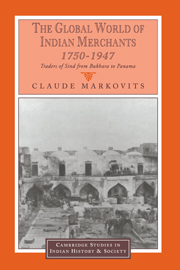Book contents
- Frontmatter
- Contents
- List of maps
- List of tables
- Acknowledgements
- Glossary
- Introduction
- 1 South Asian merchant networks
- 2 The regional context: Sind economy and society, c. 1750–1950
- 3 The Gate of Khorrassan: the Shikarpuri network, c. 1750–1947
- 4 From Kobe to Panama: the Sindworkies of Hyderabad
- 5 Patterns of circulation and business organization in two merchant networks
- 6 The business of the Sind merchants
- 7 The politics of merchant networks
- 8 Community and gender in two merchant networks
- 9 Epilogue: the Sindhi diaspora after 1947
- Conclusion
- Appendices
- Bibliography
- Index
9 - Epilogue: the Sindhi diaspora after 1947
Published online by Cambridge University Press: 22 October 2009
- Frontmatter
- Contents
- List of maps
- List of tables
- Acknowledgements
- Glossary
- Introduction
- 1 South Asian merchant networks
- 2 The regional context: Sind economy and society, c. 1750–1950
- 3 The Gate of Khorrassan: the Shikarpuri network, c. 1750–1947
- 4 From Kobe to Panama: the Sindworkies of Hyderabad
- 5 Patterns of circulation and business organization in two merchant networks
- 6 The business of the Sind merchants
- 7 The politics of merchant networks
- 8 Community and gender in two merchant networks
- 9 Epilogue: the Sindhi diaspora after 1947
- Conclusion
- Appendices
- Bibliography
- Index
Summary
The partition of British India brought in its wake a large-scale exodus of non-Muslims from Sind to independent India. Banias from Shikarpur and Hyderabad left en masse. They settled mostly in Bombay, but many did not remain there more than a few years. The existence of a functioning network of firms, mostly Hyderabadi, facilitated relocation abroad. Therefore, from the 1950s onwards, there grew a world-wide Sindhi diaspora around the core formed by the Sindwork merchants. At first this Sindhi diaspora remained a purely merchant community, but in the 1960s Amil professionals started in their turn to migrate in significant numbers, mostly to North America. In the 1990s, the Sindhi diaspora consisted of two kinds of communities: on the one hand, communities which were still largely engaged in trading, i.e. most of the dispersed Sindhi communities across Asia, Africa, Latin America and the Caribbean; on the other hand, communities which were more diversified in their occupations, with a predominance of professionals, especially in the United States, Canada and the United Kingdom.
The exodus of Sindhi Hindus to India, 1947–1948
Sindhi Hindus seem to have been caught largely by surprise and were unprepared when the political situation in India made the partition of the country an inevitable outcome of growing Hindu–Muslim tensions and of the failure of Congress and the Muslim League to reach an agreement.
- Type
- Chapter
- Information
- The Global World of Indian Merchants, 1750–1947Traders of Sind from Bukhara to Panama, pp. 277 - 285Publisher: Cambridge University PressPrint publication year: 2000

